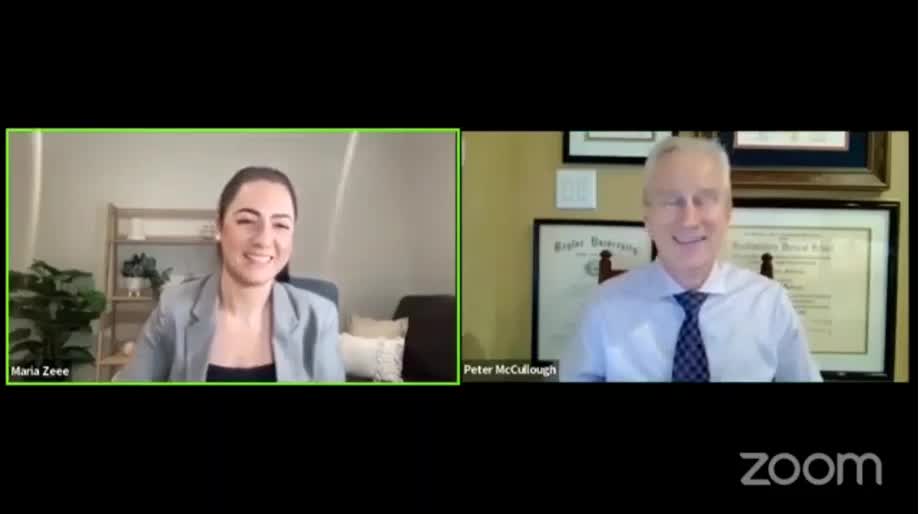Premium Only Content

Dr Peter McCullough-The COVID Vaccines Are Killing People
Dr Peter McCullough-The COVID Vaccines Are Killing People
Dr Peter McCullough Interview - The Vaccines are Killing People
November 26, 2021
The video above features Dr. Peter McCullough, a cardiologist, internist and epidemiologist, and editor of two peer-review journals, who has been on the media and medical frontlines fighting for early COVID treatment. McCullough has also been outspoken about the potential dangers of the COVID shots, and the lack of necessity for them. Curiously, agencies that are currently calling the shots do not have the authority to dictate how medicine is practiced.
The U.S. Food and Drug Administration, for example, has no power to tell doctors what to do or how to treat patients. The National Institutes of Health are a government research organization and cannot tell doctors how to treat patients.
Ditto for the U.S. Centers for Disease Control and Prevention, which is an epidemiologic analysis organization. It is the job of practicing doctors to identify appropriate and effective treatment protocols, which is precisely what McCullough has been doing since the start of this pandemic.
In August 2020, McCullough's landmark paper "Pathophysiological Basis and Rationale for Early Outpatient Treatment of SARS-CoV-2 Infection" was published online in the American Journal of Medicine.
A follow-up paper, "Multifaceted Highly Targeted Sequential Multidrug Treatment of Early Ambulatory High-Risk SARS-CoV-2 Infection (COVID-19)" was published in Reviews in Cardiovascular Medicine in December 2020.2 It became the basis for a home treatment guide.
COVID Shots Are Dangerous and Ineffective
When it comes to the COVID injections, McCullough cites research showing those at highest risk of dying from COVID-19 are also at highest risk of dying from the COVID shot. Additionally, the shots are causing severe heart damage in younger people whose risk of dying from COVID is inconsequential.
He points out the safety signal is very clear, with 19,249 deaths having been reported to the U.S. Vaccine Adverse Events Reporting System as of November 19, 2021.3
The signal is also consistent both internally and externally. A number of side effects are reported in high numbers, and very close to the time of injection, that validate the suspicion that the shots are at fault. The U.S. data are also consistent with data from other countries, such as the Yellow Card system in the U.K.
Despite that, not a single safety review has been conducted to weed out risk factors and the like. “We’re almost a year into the program and there’s been no attempt at risk mitigation,” McCullough says. At the same time, there have been gross attempts to coerce Americans into taking the shots — everything from free beer or a free lap dance, to million-dollar lotteries and paid scholarships to state universities.
Such enticements are an undeniable violation of research ethics that strictly forbid any and all kinds of coercion of human subjects. As suspected and predicted, no sooner had bribery stopped working than government officials started talking about vaccine mandates.
President Biden infamously stated that his patience with “vaccine hesitancy” was “wearing thin.” The insinuation was that if people didn’t get the shot, they’d face serious repercussions, and we’re now seeing those repercussions play out day by day, as people are being fired and kicked out of school for refusing the jab.
Meanwhile, they haven’t even determined which vaccine is the most effective, which is remarkable. If government really wanted to end the pandemic with a vaccine, wouldn’t they determine which shot works the best and promote the use of that? But no, they tell us any shot will do.
“The fact that there’s no safety report, they’re not telling you if you’re taking the best vaccine, the fact that it’s kind of in a distorted way linked to your ability to work and go to school, that we’re violating the Nuremberg Code, violating the declaration of Helsinki — it’s just not adding up. It’s not looking good for those who are promoting the vaccine,” McCullough says.
Add to all that the now-clear finding that the shots offer only limited protection for a very short time — six months at best. According to McCullough, there are more than 20 studies showing efficacy drops to nothing at the six-month mark. They’ve also had very limited effectiveness against the Delta variant, which has been the predominant strain for several months.
Why Booster Treadmill Is Such a Health Hazard
I’ve often stated that, in all likelihood, your risk of side effects will rise with each additional shot. McCullough cites research showing your body will produce the toxic SARS-CoV-2 spike protein for 15 months.
If your body is still producing the spike protein — which is what’s causing the blood clots and cardiovascular damage — and you take an additional shot every six months, there will come a time when your body simply cannot withstand the damage being caused by all the spike protein being produced.
Also consider this: While you only get at most six months’ worth of protection from any given shot, each injection will cause damage for 15 months. If we continue with boosters, eventually, it’s going to be impossible to ever clear out the spike protein.
While the spike protein is the part of the virus chosen as the antigen, the part that triggers an immune response, it’s also the part of the virus that causes the worst disease. The spike protein is responsible for COVID-19-related heart and vascular problems, and it has the same effect when produced by your own cells.
It causes blood clots, myocarditis and pericarditis, strokes, heart attacks and neurological damage, just to name a few. As noted by McCullough, the spike protein of this virus was genetically engineered to be more dangerous to humans than any previous coronavirus, and that is what the COVID shots are programming your cells to produce. “They’re just grossly unsafe for human use,” McCullough says.
Myocarditis Will Likely Be Widespread
He goes on to discuss research from 2017,4 which showed myocarditis in children and youth occurs at a rate of four cases per million per year. Assuming there are 60 million American children, the background rate for myocarditis would be 240 cases a year. How many cases of myocarditis have been reported to VAERS following COVID injection so far? 14,428 as of November 19, 2021.5
“Doctors have never seen so many cases of myocarditis,” McCullough says, citing research showing that among children between the ages of 12 and 17, 87% are hospitalized after receiving the shot. “That’s how dangerous it is,” he says. “It is frequent, and it is severe.”
Yet the FDA claims myocarditis after the COVID shot is “rare and mild.” We’re now also getting reports of fatal cases of myocarditis in adults in their 30s and 40s. “Myocarditis right now looks like an unqualified disaster,” McCullough says, both for younger people and adults.
Children aged 12 to 17 are five times more likely to be hospitalized with COVID jab-induced myocarditis than they are to be hospitalized for COVID infection.
Sadly, children also reap no benefit from the shots, so it’s all risk and no benefit for them. McCullough points out there has been no recorded school outbreaks and no child-to-teacher transmission. He estimates 80% of school aged children are already immune, which would explain this.
Meanwhile, research cited in the interview found that children aged 12 to 17 are five times more likely to be hospitalized with COVID jab-induced myocarditis than they are to be hospitalized for COVID infection. These data counter the claim that COVID-induced heart problems are a far greater problem than “vaccine”-induced heart damage.
And let’s not forget, if you take a COVID shot, you have a 100% chance of being exposed to whatever risk is associated with that shot. On the other hand, if you decline the injection, it’s not 100% chance you’ll get COVID-19, let alone die from it. You have a less than 1% chance of being exposed to SARS-CoV-2 and getting sick.
So, it’s 100% deterministic that taking the shot exposes you to the risks of the shot, and less than 1% deterministic that you’ll get COVID if you don’t take the shot.
COVID-19 Unrelated to Vaccination Rates
As noted by McCullough, rates of COVID are higher now in the highest vaccinated areas than they were before the vaccine rollout. That too tells us they aren’t working and not worth the risk.
He cites research6 published September 30, 2021, in the European Journal of Epidemiology, which found no relationship between COVID-19 cases and levels of vaccination in 68 countries worldwide and 2,947 counties in the U.S. If anything, areas with high vaccination rates had slightly higher incidences of COVID-19. According to the authors:7
“[T]he trend line suggests a marginally positive association such that countries with higher percentage of population fully vaccinated have higher COVID-19 cases per 1 million people.”
Iceland and Portugal, for example, where more than 75% of their populations are fully vaccinated, had more COVID-19 cases per 1 million people than Vietnam and South Africa, where only about 10% of the populations are fully vaccinated.8 Data from U.S. counties showed the same thing. New COVID-19 cases per 100,000 people were “largely similar,” regardless of the percentage of a state’s population that was fully vaccinated.
“There … appears to be no significant signaling of COVID-19 cases decreasing with higher percentages of population fully vaccinated,” the authors wrote.9 Notably, out of the five U.S. counties with the highest vaccination rates — ranging from 84.3% to 99.9% fully vaccinated — four of them were on the U.S. Centers for Disease Control and Prevention’s “high transmission” list. Meanwhile, 26.3% of the 57 counties with “low transmission” have vaccination rates below 20%.
The study even accounted for a one-month lag time that could occur among the fully vaccinated, since it’s said that it takes two weeks after the final dose for “full immunity” to occur. Still, “no discernable association between COVID-19 cases and levels of fully vaccinated” was observed.10
Hospitalization rates for severe COVID infection have also risen, from 0.01% in January 2021 to 9% in May 2021, and the COVID death rate rose from zero percent to 15.1% in that same timeframe.11 In short, everything is getting worse, not better, the more people get these shots.
Allowing natural immunity to build is really the only rational way forward. But then again, the COVID jabs aren’t about protecting public health. They’re about ushering in a socio-economic control system via vaccine passports, which is something McCullough doesn’t discuss in this interview. Nothing makes sense if you look at it from a medical standpoint. It only makes sense if you see it for what it is, which is a control system.
Natural Immunity Is ‘Infinitely Better’ Than Vaccine Immunity
According to McCullough, “natural immunity is infinitely better than vaccine immunity,” and studies have borne that out time and again. The reason natural immunity is superior to vaccine-induced immunity is because viruses contain five different proteins.
The COVID shot induces antibodies against just one of those proteins, the spike protein, and no T cell immunity. When you’re infected with the whole virus, you develop antibodies against all parts of the virus, plus memory T cells.
This also means natural immunity offers better protection against variants, as it recognizes several parts of the virus. If there are significant alternations to the spike protein, as with the Delta variant, vaccine-induced immunity can be evaded. Not so with natural immunity, as the other proteins are still recognized and attacked.
Here’s a sampling of scholarly publications that have investigated natural immunity as it pertains to SARS-CoV-2 infection. There are several more in addition to these:12
Science Immunology October 202013 found that “RBD-targeted antibodies are excellent markers of previous and recent infection, that differential isotype measurements can help distinguish between recent and older infections, and that IgG responses persist over the first few months after infection and are highly correlated with neutralizing antibodies.”
The BMJ January 202114 concluded that “Of 11, 000 health care workers who had proved evidence of infection during the first wave of the pandemic in the U.K. between March and April 2020, none had symptomatic reinfection in the second wave of the virus between October and November 2020.”
Science February 202115 reported that “Substantial immune memory is generated after COVID-19, involving all four major types of immune memory [antibodies, memory B cells, memory CD8+ T cells, and memory CD4+ T cells].
About 95% of subjects retained immune memory at ~6 months after infection. Circulating antibody titers were not predictive of T cell memory. Thus, simple serological tests for SARS-CoV-2 antibodies do not reflect the richness and durability of immune memory to SARS-CoV-2.”
A 2,800-person study found no symptomatic reinfections over a ~118-day window, and a 1,246-person study observed no symptomatic reinfections over 6 months.
A February 2021 study posted on the prepublication server medRxiv16 concluded that “Natural infection appears to elicit strong protection against reinfection with an efficacy ~95% for at least seven months.”
An April 2021 study posted on medRxiv17 reported “the overall estimated level of protection from prior SARS-CoV-2 infection for documented infection is 94.8%; hospitalization 94.1%; and severe illness 96·4%. Our results question the need to vaccinate previously-infected individuals.”
Another April 2021 study posted on the preprint server BioRxiv18 concluded that “following a typical case of mild COVID-19, SARS-CoV-2-specific CD8+ T cells not only persist but continuously differentiate in a coordinated fashion well into convalescence, into a state characteristic of long-lived, self-renewing memory.”
A May 2020 report in the journal Immunity19 confirmed that SARS-CoV-2-specific neutralizing antibodies are detected in COVID-19 convalescent subjects, as well as cellular immune responses. Here, they found that neutralizing antibody titers do correlate with the number of virus-specific T cells.
A May 2021 Nature article20 found SARS-CoV-2 infection induces long-lived bone marrow plasma cells, which are a crucial source of protective antibodies. Even after mild infection, anti-SARS-CoV-2 spike protein antibodies were detectable beyond 11 months’ post-infection.
A May 2021 study in E Clinical Medicine21 found “antibody detection is possible for almost a year post-natural infection of COVID-19.” According to the authors, “Based on current evidence, we hypothesize that antibodies to both S and N-proteins after natural infection may persist for longer than previously thought, thereby providing evidence of sustainability that may influence post-pandemic planning.”
Cure-Hub data22 confirm that while COVID shots can generate higher antibody levels than natural infection, this does not mean vaccine-induced immunity is more protective. Importantly, natural immunity confers much wider protection as your body recognizes all five proteins of the virus and not just one. With the COVID shot, your body only recognizes one of these proteins, the spike protein.
A June 2021 Nature article23 points out that “Wang et al. show that, between six and 12 months after infection, the concentration of neutralizing antibodies remains unchanged. That the acute immune reaction extends even beyond six months is suggested by the authors’ analysis of SARS-CoV-2-specific memory B cells in the blood of the convalescent individuals over the course of the year.
These memory B cells continuously enhance the reactivity of their SARS-CoV-2-specific antibodies through a process known as somatic hypermutation. The good news is that the evidence thus far predicts that infection with SARS-CoV-2 induces long-term immunity in most individuals.”
Reinfection Is Very Rare
McCullough stresses there is also no need to worry about reinfection if you’ve already had COVID once. The fact is, while breakthrough cases continue among those who have gotten one or more COVID-19 injections, it’s extremely rare to get COVID-19 after you’ve recovered from the infection.
How rare? Researchers from Ireland conducted a systematic review including 615,777 people who had recovered from COVID-19, with a maximum duration of follow-up of more than 10 months.24
“Reinfection was an uncommon event,” they noted, “with no study reporting an increase in the risk of reinfection over time.” The absolute reinfection rate ranged from 0% to 1.1%, while the median reinfection rate was just 0.27%.25,26,27
Another study revealed similarly reassuring results. It followed 43,044 SARS-CoV-2 antibody-positive people for up to 35 weeks, and only 0.7% were reinfected. When genome sequencing was applied to estimate population-level risk of reinfection, the risk was estimated at 0.1%.28
There was no indication of waning immunity over seven months of follow-up, unlike with the COVID-19 injection, which led the researchers to conclude that “Reinfection is rare. Natural infection appears to elicit strong protection against reinfection with an efficacy >90% for at least seven months.”29
“It’s a one-and-done,” McCullough says. If you’ve had it once, you won’t get it again. He also advises against using PCR testing after you’ve had confirmed COVID-19 once, as any subsequent positive tests are just going to be false positives.
Early Treatment Options
In closing, should you get COVID-19, know there are several very effective early treatment options, and early treatment is key, both for preventing severe infection and preventing “long-haul COVID.” Here are a few suggestions:
•Oral-nasal decontamination — The virus, especially the Delta variant, replicates rapidly in the nasal cavity and mouth for three to five days before spreading to the rest of the body, so you want to strike where it’s most likely to be found right from the start.
Research30 has demonstrated that irrigating your nasal passages with 2.5 milliliters of 10% povidone-iodine (an antimicrobial) and standard saline, twice a day, is an effective remedy.
Another option that was slightly less effective was using a mixture of saline with half a teaspoon of sodium bicarbonate (an alkalizer). You can also gargle with these to kill viruses in your mouth and throat. When done routinely, it can be a very effective preventive strategy. You can find printable treatment guides on TruthForHealth.org.
•Nebulized peroxide — A similar strategy is to use nebulized hydrogen peroxide, diluted with saline to a 0.1% solution. Both hydrogen peroxide and saline31,32 have antiviral effects.
In a May 10, 2021, Orthomolecular Medicine press release,33 Dr. Thomas E. Levy — board-certified in internal medicine and cardiology — discussed the use of this treatment for COVID-19 specifically. Levy has in fact written an entire book on peroxide nebulization called “Rapid Virus Recovery,” which you can download for free from MedFox Publishing.
•Vitamin D optimization — Research has shown having a vitamin D level above 50 ng/mL brings the risk of COVID mortality down to near-zero.34
•Other key nutraceuticals — Vitamin C, zinc, quercetin and NAC all have scientific backing.
•Key drugs — For acute infection, ivermectin, hydroxychloroquine or monoclonal antibodies can be used. While monoclonal antibodies and hydroxychloroquine must be used early on in the disease process, ivermectin has been shown to be effective in all stages of the infection.
Doxycycline or azithromycin are typically added as well, to address any secondary bacterial infection, as well as inhaled budesonide (a steroid). Oral steroids are used on and after the fifth day for pulmonary weakness and aspirin or NAC can be added to reduce the risk of clotting. In the interview, McCullough discusses the use of each of these, and other, drugs.
One drug I disagree with is full-strength aspirin. I believe a potentially better, at least safer, alternative would be to use the enzymes lumbrokinase and
Dr serrapeptase, as they help break down and prevent blood clots naturally.
Peter McCullough is a world-renowned Cardiologist who has been speaking about the risks of heart complications associated with the vaccines, particularly in relation to younger people.
Links to the sources Dr McCullough mentioned:
https://www.truthforhealth.org
https://aapsonline.org
https://americasfrontlinedoctors.org
https://covid19criticalcare.com
https://worldcouncilforhealth.org
https://covidmedicalnetwork.com
https://www.pandata.org
THE MCCULLOUGH REPORT
https://www.iheart.com/podcast/53-the-mccullough-report-88800688/
Source: Maria Zeee https://rumble.com/vpq5u8-dr-peter-mccullough-interview.html
-
 2:40:09
2:40:09
Live Free or Die
9 days agoDr Lee Merritt with Dr Ben Marble 12-08-2024
9905 -
 1:00:49
1:00:49
Allie Beth Stuckey
3 years agoThese COVID Lies Are Killing People | Ep 491
8322 -
 10:45
10:45
Bannons War Room
3 years agoThe Media Is Killing People
5.42K87 -
 0:18
0:18
KTNV
3 years agoWebsite connecting people with COVID vaccines
8425 -
 1:00:46
1:00:46
The StoneZONE with Roger Stone
5 hours agoFake News Attack on Tulsi Gabbard! | The StoneZONE w/ Roger Stone
35.7K14 -
 2:24:08
2:24:08
WeAreChange
8 hours agoElon Musk & Donald Trump: The Emergency Halt That Saved Us
69.2K55 -
 1:13:11
1:13:11
Flyover Conservatives
1 day agoWARNING! Is Bitcoin CIA-Controlled? – The Shocking Reality of Digital Assets - Clay Clark | FOC Show
27.4K6 -
 2:00:37
2:00:37
Space Ice
11 hours agoSpace Ice & Redeye Try To Figure Out Seagal's Most Incoherent Movie
96.6K3 -
 1:00:36
1:00:36
PMG
1 day ago $8.38 earned"Santa Trump is Giving Us Hope - But Will Johnson Stand Strong?"
80.9K13 -
 54:30
54:30
LFA TV
1 day agoThe German Strongman’s Arrival Is Imminent | Trumpet Daily 12.18.24 7PM EST
62.4K3